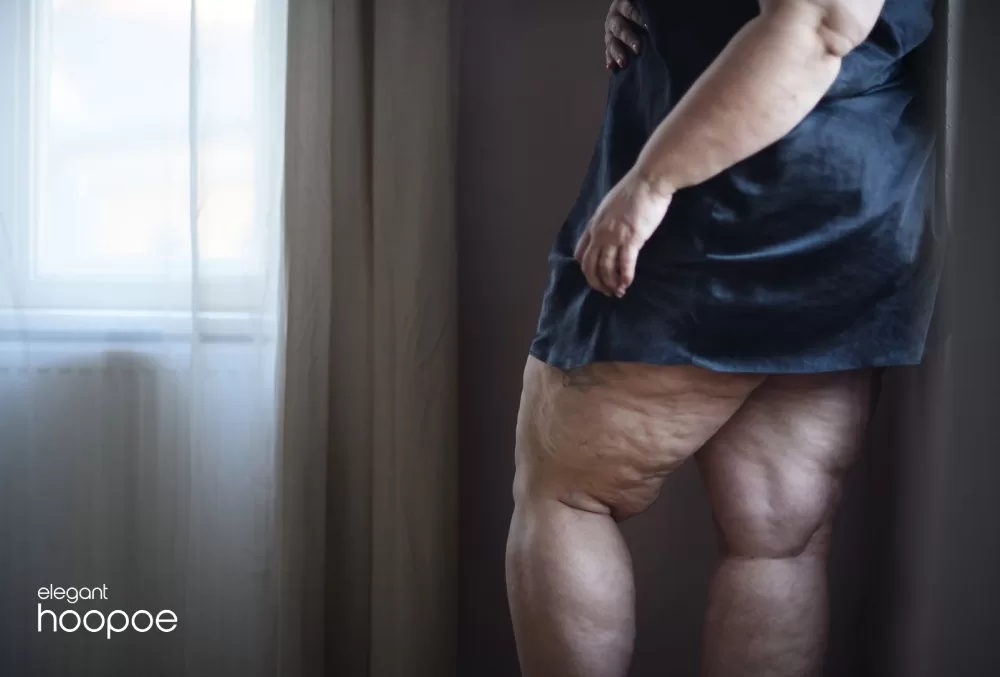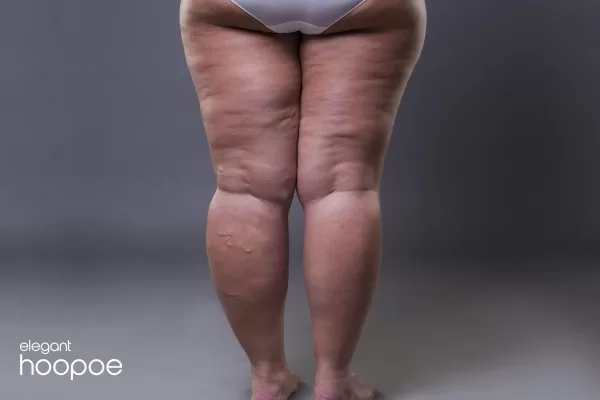Fat accumulation in human body is a completely natural process and fat deposits are usually created evenly throught the body. Sometimes however, fat accumulation happens abnormally and mostly in the lower half of the body. This condition is known as Lipedema, and Despite its prevalence, many individuals remain unaware of this condition, leading to misdiagnosis and inadequate treatment. In this article of elegant hoopoe, we delve into the essential aspects of this condition, including its signs and symptoms, potential causes, methods of diagnosis, and available management options. Additionally, we explore the impact of lipedema on both physical and mental well-being, as well as the latest advancements in research and treatment.
Related services:
What is Lipedema?

Lipedema, pronounced “lip-uh-dee-muh,” is a chronic condition that affects the distribution of fat in the body, primarily in the legs and sometimes in the arms. This condition is characterized by an abnormal accumulation of fat cells that can lead to an uneven, disproportionate appearance.
While the exact prevalence of lipedema is unknown, it is estimated to affect millions of people worldwide, primarily women. It often starts around puberty or other hormonal transitions, and it tends to worsen over time if left untreated. Unfortunately, this chronic condition is often underdiagnosed or misdiagnosed, leading to years of frustration for those affected.
Related article: How to Get Rid of Cellulite?
Distinguishing Lipedema from Other Conditions
Lipedema is often mistaken for regular obesity or lymphedema due to its similar symptoms. However, there are some distinguishing features. Unlike obesity, accumulated fat typically does not respond well to dieting or exercise. Additionally, it does not cause the pitting edema commonly associated with lymphedema.
Signs and Symptoms of Lipedema
Early Signs and Symptoms

The earliest signs of lipedema usually involve the lower body, including the hips, thighs, and buttocks. These areas may appear disproportionately large compared to the upper body. Some individuals may also experience tenderness or pain in these areas, even when lightly touched.
Progression of Lipedema Symptoms
Lipedema is a progressive condition, meaning it tends to worsen over time if not properly managed. In later stages, the arms may also be affected, causing a “bracelet” appearance around the wrists. Additionally, individuals suffering from this condition may experience easy bruising, sensitivity to touch, and a heavy or swollen sensation in the affected areas.
Typical Distribution of Fat in Lipedema
One of the key features of lipedema is its characteristic fat distribution. Unlike regular weight gain, which tends to be symmetrical, lipedema fat accumulates in a column-like pattern, often sparing the feet and hands. This creates a distinct “column leg” appearance, with excess fat extending from the hips down to the ankles. Understanding these unique fat deposition patterns can aid in identifying this condition.
Related article: Best At Home Body Shaping Devices
Can lipedema be cured?
Lipedema is a chronic condition, meaning there is currently no known cure. However, various treatment approaches, including conservative management techniques, compression therapy, and surgical interventions, can help manage the symptoms and improve the quality of life for individuals with lipedema.
For those who do not like to undergo surgical procedures, there are also some non-surgical methods to remove extra fat pockets from different parts of the body. Here at elegant hoopoe, we offer a wide range of non-surgical fat removal Services in UAE. Contact us to get more details on our procedures.
Causes and Risk Factors of Lipedema
Possible Genetic Links
Researchers believe that genetics may play a role in the development of lipedema, as it often runs in families. Certain genetic factors may predispose individuals to the condition, although more research is needed to fully understand the underlying mechanisms.
Hormonal Influences
Hormonal changes, such as those occurring during puberty, pregnancy, or menopause, can trigger or exacerbate lipedema symptoms. Estrogen, in particular, is thought to have a significant influence on the condition. This hormonal component helps explain why this disease primarily affects women.
Role of Obesity and Weight Gain
While lipedema is not caused by obesity, weight gain can worsen its symptoms. Excessive weight gain can put additional strain on the lymphatic system, exacerbating fluid accumulation and inflammation in the affected areas. Maintaining a healthy weight and lifestyle can help manage lipedema and improve overall well-being.
Related article: Hormonal Weight Gain
Diagnosing Lipedema
Medical History and Physical Examination
A thorough medical history review and a comprehensive physical examination are crucial steps in diagnosing this condition. The healthcare provider will inquire about symptoms, progression, and any relevant family history. They will also assess the appearance and feel of the affected areas to determine if lipedema is likely.
Diagnostic Criteria and Guidelines
Various diagnostic criteria and guidelines have been established to aid healthcare professionals in diagnosing this chronic disease. These criteria take into account the characteristic fat distribution patterns, symptoms, and other clinical findings. However, it is important to note that there is no single standardized diagnostic test for lipedema.
Imaging and Laboratory Tests
In some cases, imaging techniques such as ultrasound or MRI scans may be used to assess the thickness and structure of fat tissue. These imaging studies can help differentiate lipedema from other conditions and provide additional evidence for diagnosis. Laboratory tests are usually not necessary for diagnosing lipedema but may be performed to rule out other underlying conditions.
Remember, if you suspect you may have lipedema, it is always best to consult with a healthcare professional for an accurate diagnosis and personalized treatment plan.
Related article: Laser lipo vs Bodytite
Managing Symptoms and Challenges
Physical and Emotional Impact of Lipedema
Lipedema can have both physical and emotional impacts on those who live with it. From a physical standpoint, the condition is characterized by an abnormal accumulation of fat mainly in the legs and sometimes in the arms. This can lead to pain, tenderness, and easy bruising. The disproportionate distribution of fat can also cause difficulty with mobility and finding clothing that fits properly.
On an emotional level, living with such condition can be challenging. Society often associates body shape and size with personal worth, leading to feelings of self-consciousness and low self-esteem. The frustration of not being able to achieve desired weight loss despite efforts can also take a toll on mental well-being.
Self-Care Practices for Lipedema
While there is currently no cure for lipedema, there are self-care practices that can help manage its symptoms. Regular exercise, such as low-impact activities like swimming or walking, can improve circulation and reduce swelling. Eating a balanced diet and maintaining a healthy weight can also help manage symptoms.
Related article: Walking Plan Based on BMI, How much you should walk?
Additionally, practicing good skincare by keeping the affected areas clean and moisturized can promote skin health and reduce the likelihood of infections. It’s important to listen to your body, rest when needed, and avoid activities that aggravate symptoms.
Supportive Garments and Compression Therapy
Supportive garments and compression therapy can provide relief and support for individuals with lipedema. Compression garments, such as specialized stockings or leggings, help improve circulation, reduce swelling, and provide support to the affected areas.
These garments are designed to exert pressure on the tissues, helping to move excess fluid and reduce pain. They can be particularly beneficial during periods of prolonged sitting or standing or when engaging in physical activities. It is essential to consult with a healthcare professional to determine the appropriate level of compression and the best type of garment for your specific needs.
How to treat Lipedema?
Conservative Management Techniques

Conservative management techniques are often the first line of treatment for this condition. These include lifestyle modifications such as maintaining a healthy weight with following a diet and exercise plan, practicing self-care techniques, and using compression garments. While these approaches may not reverse the condition, they can help manage symptoms, reduce pain, and improve overall quality of life.
Manual Lymphatic Drainage (MLD) Therapy
Manual Lymphatic Drainage (MLD) therapy is a specialized massage technique that aims to improve lymphatic flow and reduce swelling. This therapy involves gentle, rhythmic movements applied to the affected areas to stimulate the lymphatic system and promote proper drainage of fluid.
MLD therapy is typically performed by a trained therapist and can be a valuable addition to lipedema management. It can help alleviate discomfort, reduce swelling, and improve mobility. However, it’s important to consult with a healthcare professional to determine if MLD therapy is appropriate for your specific situation.
Related article: How to Tighten The Skin After Weight Loss?
Surgical Treatments for Lipedema
In some cases, surgical interventions may be considered for lipedema. These procedures aim to remove excessive fat deposits and reshape the affected areas. Liposuction techniques specifically designed for this chronic condition, such as tumescent liposuction or water-assisted liposuction, can provide long-lasting results.
Surgical interventions are typically considered when conservative management techniques have not provided sufficient relief or if the lipedema is causing significant functional impairment. It’s crucial to consult with a qualified healthcare professional to discuss the potential risks and benefits of surgical interventions and determine the most appropriate approach for your individual case.
Lipedema and Mental Health
Psychological Effects of Lipedema
Living with lipedema can have a significant impact on mental health. The physical symptoms and appearance changes associated with the condition often lead to feelings of self-consciousness, body image dissatisfaction, and low self-esteem. These psychological effects can contribute to anxiety, depression, and social isolation.
Coping Strategies and Support Networks
Developing effective coping strategies and building a support network can play a vital role in addressing the emotional challenges of lipedema. Engaging in activities that boost self-confidence and self-care, such as practicing mindfulness or pursuing hobbies, can help improve overall well-being.
Building connections with individuals who understand and empathize with the condition, such as support groups or online communities, can provide a sense of belonging and support. It’s important to remember that you are not alone in your struggles, and seeking support can make a significant difference in managing the emotional impact of lipedema.
Mental Health Professionals’ Role
Mental health professionals, such as therapists or counselors, can provide valuable support in addressing the emotional well-being of individuals living with lipedema. Through therapy, individuals can explore and process their feelings, develop coping strategies, and work towards improving self-esteem and body image.
These professionals can also offer guidance on managing anxiety and depression that may arise from living with a chronic condition. Collaborating with a mental health professional can be an essential part of a holistic approach to managing the condition and promoting emotional well-being.
Research and Future Perspectives
Current Research and Studies
Ongoing research and studies are continually advancing our understanding of this disease. Researchers are investigating various aspects of the condition, including its causes, potential genetic factors, and the development of targeted treatments.
Through these studies, scientists aim to uncover new insights into the mechanisms behind lipedema, identify diagnostic markers, and develop more effective treatment options. These advancements have the potential to improve the lives of individuals living suffering from this condition and promote earlier diagnosis and intervention.
Promising Treatment Innovations
As research progresses, promising treatment innovations for lipedema are being explored. These include non-invasive techniques, such as laser therapy or radiofrequency, which may help reduce fat accumulation and improve symptoms.
Additionally, advancements in surgical techniques continue to refine liposuction approaches tailored specifically for lipedema, resulting in more precise and successful outcomes. The development of targeted medications that directly address the underlying causes of lipedema is also an area of active investigation.
Related article: How To Lose Face Fat?
Advocacy and Awareness Efforts
Advocacy and awareness efforts are crucial in increasing recognition and understanding of this disease. Organizations and support groups dedicated to lipedema work to raise awareness among healthcare professionals, policymakers, and the general public. They strive to promote accurate diagnosis, proper treatment, and improved access to care for individuals suffering from this condition.
Through education and advocacy, these initiatives aim to reduce the stigma associated with lipedema, encourage research funding, and improve the overall quality of life for those affected by the condition.
Remember, this chronic condition affects lots of lives but it does not define who you are. With the right support, self-care practices, and treatment options, individuals with lipedema can navigate the challenges and live fulfilling lives. In conclusion, understanding this condition is crucial for accurate diagnosis, appropriate management, and enhanced quality of life for individuals living suffering from it.
By recognizing the signs and symptoms, identifying the underlying causes, and exploring various treatment options, individuals with lipedema can find effective ways to manage their symptoms and improve their overall well-being. With ongoing research and increased awareness, we can continue to advance our understanding of lipedema, provide better support for those affected, and ultimately strive for a future where lipedema is widely recognized and properly addressed.







